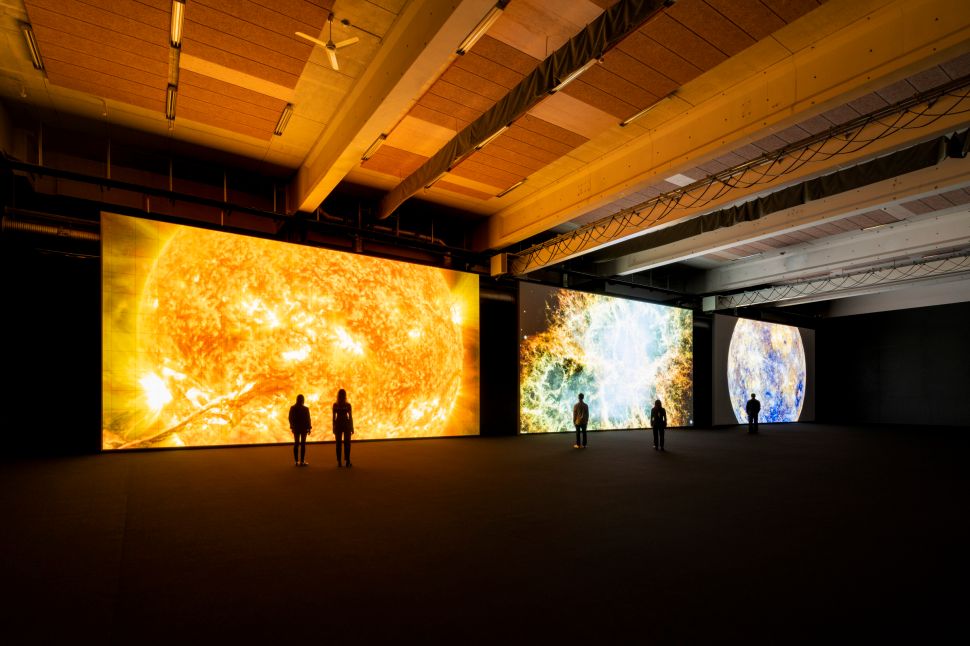Absolute black. Absolute white. The point of no return. Infinity. The concepts that lie at the outermost edge of what our minds can comprehend are at the center of Ryoji Ikeda’s exhibition “data-verse” at the High Museum of Art. While easy to name, these concepts are nearly impossible to visualize, let alone visualize in a manner in which the gravity of their meanings can be felt.
The exhibition begins with point of no return (2018), a two-part video and light installation. The front of the installation features a large wall onto which is projected a perfectly round black circle bordered by a rapidly flickering ring of white light. As the circumscribing lights flutter, they seem to animate the void in the center of the wall. Though it contains no light, it vibrates with immense power. This feeling of immensity is amplified by an ambient soundtrack featuring a low-level hum, a sound that is carried throughout the exhibition. On the backside of this video projection is a similarly massive perfect circle of white light generated from a freestanding lighting fixture in the gallery. The two halves of this installation are inverses of one another. Taken together, they cancel out perfectly. The title of the artwork is drawn from the moment when escape from a black hole becomes impossible, turning around is no longer an option. An ominous way to begin an exhibition—one that says only unknowable things lie ahead, and we can do nothing to stop ourselves from meeting them.
The exhibition continues with mass (2023), a near replica of the projected wall in point of no return, albeit even larger this time. Covering a space some dozens of feet square on the floor of a huge gallery, mass features the same black void with flickering peripherals. But while point of no return is a largely static video work, mass is not. As the viewer watches, the void in the center of the projection constantly expands until it consumes the entirety of its peripherals, dousing the gallery in near-complete darkness until the video begins again with the ever-expanding void. If point of no return was the doorway to the exhibition, mass is the enactment of us stepping through it—a visualization of our bodies being swallowed by a black hole. Now, we are beyond knowing; now, we are beyond our world, into something indefinable.
And what more fitting thing to emerge from the tenebrous black we find ourselves in than a line? Line (2008) is exactly as its title describes—a perfectly uniform line of white light running vertically from the floor to the top of the wall in the next gallery. This artwork is deceptively simple, as ‘simple’ is often the most difficult idea to execute. Exquisite in its craftsmanship, the artwork expresses multiple fundamental aspects of our universe—dimension, light, space and place. From the darkness arise the fundamentals in preparation for the chaos to come.
SEE ALSO: In Atlanta, ‘Innervisions’ Conjures Black Abstraction as Ab-Ex’s Twin
The next gallery features the pièce-de-résistance for this exhibition and its namesake: data-verse 1/2/3 (2019-2020). In the trio of works presented as one composite installation, screens dominate the space, with each segment of the projected video covering a wall some 18 by 40 feet. Ikeda has transposed datasets from the likes of CERN and NASA—weather patterns, air travel paths and human genetic code—into composited visuals. Sometimes showing endless strands of raw data and other times showing visual manifestations of them, the video artworks begin in a relative lull, calm computation of endless items. As the videos progress, this computation becomes increasingly frantic, with both the speed at which images and data appear on the screen and the ambient soundtrack swelling. This crescendo culminates in an image of the sun synchronously appearing across all three screens. The effect is staggering. Never have I felt so small.
And perhaps that is precisely the point. In our contemporary era in the United States, we constantly face things that push our minds to the very limit of possibility and understanding. A president cutting civil services and consolidating unprecedented executive power. Climate change causing unheard-of disasters and weather patterns occurring at the most anomalous times. And buying a home feels forever out of reach for most young adults. We’re living in a world of chaos that borders on impossibility.
“data-verse” does not—cannot—assuage this mental agitation in the palliative sense, but it serves an important role as an ego killer. “I want to disappear; ‘myself’ is not important,” Ikeda told Observer in 2011. “The thing is, I made it, but it is everything. Maybe you can see that feeling in the experience of the work.” He accomplishes that and more in a show that removes the individuality that plagues contemporary struggles to flatten us all into a uniform line, reminding us of our commonalities. Come here to remember that humans are so small. Come here to remember that we are all one.
“Ryoji Ikeda: data-verse” is at the High Museum of Art through August 10.

